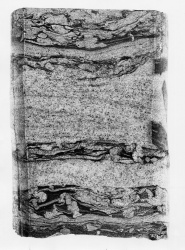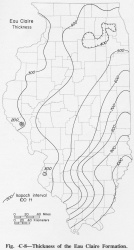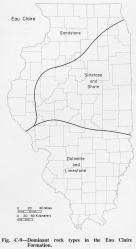Eau Claire Formation
Lithostratigraphy: Knox Dolomite Megagroup >>Eau Claire Formation
Chronostratigraphy: Paleozoic Erathem >>Cambrian System >>Croixan Series >>Dresbachian Stage
Allostratigraphy: Sauk Sequence
Primary source
Willman, H. B., Elwood Atherton, T. C. Buschbach, Charles Collinson, John C. Frye, M. E. Hopkins, Jerry A. Lineback, and Jack A. Simon, 1975, Handbook of Illinois Stratigraphy: Illinois State Geological Survey Bulletin 95, 261 p.
Contributing author(s)
T. C. Buschbach
Name
Original description
Eau Claire Formation (Ulrich, in Walcott, 1914, p. 354).
Derivation
The Eau Claire Formation is named for Eau Claire, Eau Claire County, Wisconsin.
Other names
History/background
Type section
Type location
The type section of the Eau Claire Formation is located in Eau Claire, Eau Claire County, Wisconsin, and it consists of 100 feet of thin-bedded, partly shaly, fossiliferous sandstone (fig. Є-1C).
Type author(s)
Type status
Reference section
Reference location
Reference author(s)
Reference status
Stratigraphic relationships
In northeastern Illinois the Eau Claire Formation is differentiated into three members that have been widely traced throughout the northern half of the state-the Elmhurst Sandstone Member (at the base), the Lombard Dolomite Member, and the Proviso Siltstone Member (Buschbach, 1964).
Extent and thickness
The Eau Claire Formation underlies all of Illinois, but it is not exposed. It ranges from less than 300 feet thick in the western part of the state to more than 1000 feet in the southeast (fig. Є-8).
Lithology
The Eau Claire Formation consists of dolomite and dolomitic sandstone, siltstone, and shale overlying the relatively clean sandstone of the Mt. Simon Sandstone and underlying the clean sandstone of the Galesville Sandstone. In northern and western Illinois the Eau Claire Formation is dominantly dolomitic, fine- to medium-grained, gray sandstone, but it includes shaly siltstone and silty, sandy, glauconitic, brownish gray dolomite (fig. Є-9). In central and eastern Illinois it is dominantly dolomitic, orange to pinkish gray siltstone and green, gray, or red shale, but it includes light gray, glauconitic, partly oolitic limestone and dolomite. In southern Illinois it is dominantly fine-grained,gray dolomite or limestone but it includes some beds of siltstone, shale, and sandstone. Some beds of the Eau Claire are oolitic, others are brecciated. The base of the Eau Claire is characterized by a "sooty" sandstone in which the sand grains are coated with a fine black powder consisting of pyrite (Workman and Bell, 1948).
Core(s)
Photograph(s)
Contacts
Well log characteristics
Fossils
Some beds in the Eau Claire contain abundant fragments of inarticulate brachiopods and trilobites, which can easily be observed in samples from borings, but the fauna has not been studied in Illinois.
Age and correlation
The Eau Claire is recognized from Minnesota to Kentucky and Ohio. West of Illinois it is equivalent to the Bonneterre Formation.
Environments of deposition
Economic importance
Remarks
References
BUSCHBACH, T. C., 1964, Cambrian and Ordovician strata of northeastern Illinois: Illinois State Geological Survey Report of Investigations 218, 90 p.
WALCOTT, C. D., 1914, Cambrian geology and paleontology: Smithsonian Miscellaneous Collections, v. 57, p.
WORKMAN, L. E., and A. H. BELL, 1948, Deep drilling and deeper oil possibilities in Illinois: American Association of Petroleum Geologists Bulletin, v. 32, p. 2041-2062; Illinois State Geological Survey Report of Investigations 139.
ISGS Codes
| Stratigraphic Code | Geo Unit Designation |
|---|---|


